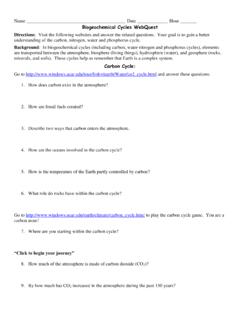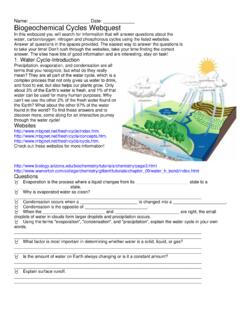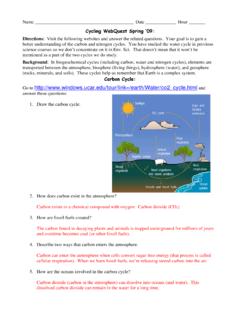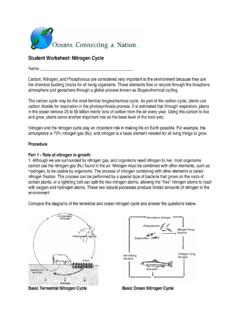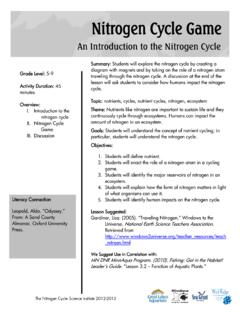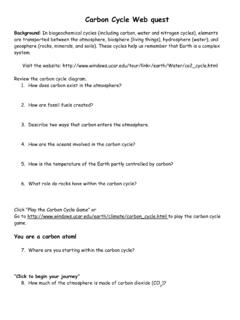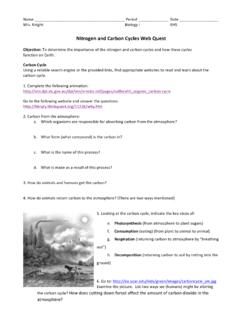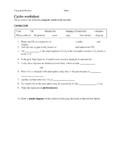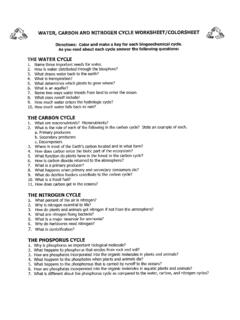Transcription of Name Date Cycling WebQuest
1 name _____ date _____ Cycling WebQuestDirections: Visit the following websites and answer the related questions. Your goal is to gain a better understanding of the carbon and nitrogen : In biogeochemical cycles (including carbon, water and nitrogen cycles), elements are transported between the atmosphere, biosphere (living things), hydrosphere (water), and geosphere (rocks, minerals, and soils). These cycles help us remember that Earth is a complex system. Carbon Cycle: Go to and answer these questions: 1. Draw the carbon cycle (on a separate piece of paper)2. How does carbon exist in the atmosphere? 3. How are fossil fuels created? Explain. 4. Describe two ways that carbon enters the atmosphere. 5. How are the oceans involved in the carbon cycle? 6. How is the temperature of the Earth partly controlled by carbon? 7. What role do rocks have within the carbon cycle? Go to to play the carbon cycle game.
2 You are a carbon atom! 8. Where are you starting within the carbon cycle? Click to begin your journey 9. How much of the atmosphere is made of carbon dioxide (CO2)? 10. By how much has CO2 increased in the atmosphere during the past 150 years? As you work through this game, take some notes about where you go as a carbon atom. Make sure you visit all reservoirs! 11. Next stop = _____ What did you learn? 12. Next stop = _____ What did you learn? The deep ocean accounts for more than _____ % of the Earth s carbon. How much carbon does the surface ocean absorb from the atmosphere each year? True or False: When plants die and decay, they bring carbon into soil. 13. Next stop = _____ What did you learn? 14. Next stop = _____ What did you learn? 15. Next stop = _____ What did you learn? When carbon enters the deep ocean, how long does it stay there? _____True or False: Phytoplankton are tiny plants and algae that float in the ocean and take up carbon dioxide as they grow.
3 True or False: Plants both absorb CO2 from the atmosphere and release it into the Cycle: Go to ~chm/onlcourse/chm110/ and answer these questions. 16. What are the two conditions under which nitrogen will react with oxygen? (In other words, what is necessary for nitrogen in the air to combine with oxygen?) 17. What are the two compounds that are formed when nitrogen combines with oxygen? 18. How does nitric acid (HNO3) form? 19. Why is nitric acid (HNO3) important? Go to: and answer these questions. 20. What percentage of the air we breathe is nitrogen ? 21. Even though considerable nitrogen is available in the air, most plants do not use the nitrogen (N2) found in the air. Why not? 22. In what compounds can plants use nitrogen ? 23. How do animals get the nitrogen they need? 24. Atmospheric nitrogen (N2) is pretty inert. This means that it does not easily break apart. When molecules do not break apart easily, it is difficult (or impossible) for organisms to use them as a nutrient source.
4 As a result, nitrogen fixation is the term used to describe the process of breaking up N2. a. What is atmospheric fixation? b. What is industrial fixation? [This is how artificial fertilizers are made.] c. What is biological fixation? (In your answer, describe the types of plants associated with the symbiotic relationship.) Go to: and answer these questions. 25. Draw the nitrogen cycle: On a separate piece of paper: (Remember there are other diagrams on the previous websites.) If you re not sure what a term means, look through the reading and links for help. 26. Why is nitrogen needed by plants and animals? Go to Answer the following "water cycle". fraction of the Earth s surface is covered in water? percentage of all the Earth s water is in a form that is useable to humans and land animals? Click on Answer the following is the process where a liquid changes from its _____ state to a _____ state.
5 Is evaporated water so clean? occurs when a _____ is changed into a _____. is the opposite of _____. the _____ and _____ are right, the small droplets of water in clouds form larger droplets and precipitation transpiration: percolation: Go to Answer the following the terms "evaporation", "condensation", and "precipitation", explain the water cycle in your own words. factor is most important in determining whether water is a solid, liquid, or gas? the amount of water on Earth always changing or is it a constant amount?
